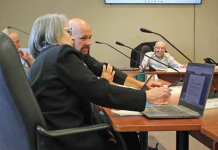The County of Haliburton is ready for a public meeting on its shoreline preservation bylaw with a possible requirement for renaturalization up for discussion.
County council reviewed the draft bylaw and new public information documents at a special meeting Nov. 23. The meeting delved into questions on the bylaw and how to present it to the public, with a variety of minor adjustments put forward for staff implementation.
One key point of discussion was over the renaturalization of shorelines. The bylaw as it stands does not require people to change already developed shorelines, only restricting future development. But councillors raised the possible need to codify shoreline renaturalization and agreed to include it as a question in upcoming consultation.
“There are passionate positions on both sides,” Coun. Carol Moffatt said. “When we look at the objectives of this bylaw (get County shorelines to 75 per cent naturalized), I don’t know if we’re going to achieve these if we don’t implement something that required renaturalization. But I think that’s a massive can of worms.”
The municipality has spent months reviewing the bylaw in response to public pushback. The Coalition of Haliburton Property Owners’ Associations (CHA) has pointed to research about shorelines requiring 75 per cent naturalization to maintain water quality and help prevent algae blooms. A CHA assessment of 60 local lakes found only 47-48 per cent of their shorelines were natural.
Deputy warden Andrea Roberts said the bylaw should remain as is, with something addressing renaturalization possibly coming later.
“How we move is a process,” Roberts said. “This is a step and I think we would be biting off more than we can chew.”
Warden Liz Danielsen said it makes sense to include it in public consultation. She added renaturalization could help alleviate the concerns landscapers have about the bylaw taking from their work.
“If we include a renaturalization component … we’re offering another opportunity. It’s just a different kind of work,” she said.
Public information addressed
Councillors spent approximately four hours reviewing the bylaw, addressing issues such as wording, fish habitat and pressuring the province to allow higher fines to stand.
They also reviewed three documents aimed at making the bylaw more digestible than the “legalese”: an illustrated summary document, a fact sheet and an online selfassessment tool to help property owners determine whether they need a permit.
The municipality has set a target date of April 15 to begin enforcement of the bylaw. Both staff and councillors called the date “ambitious” but said it could be adjusted as needed.
Council voted to receive the discussion as information and direct staff to initiate public consultation and organize a virtual public meeting. That meeting is expected to be some time in January.
Moffatt asked how much time would be allowed to review input.
“Whatever time it takes,” Danielsen responded. “There’s going to be things that we hear and agree with. There will be things we hear and disagree with or can’t do anything about for legislative reasons. We’ll have to wade through it all.”





